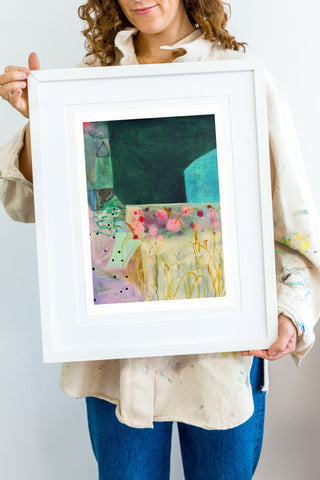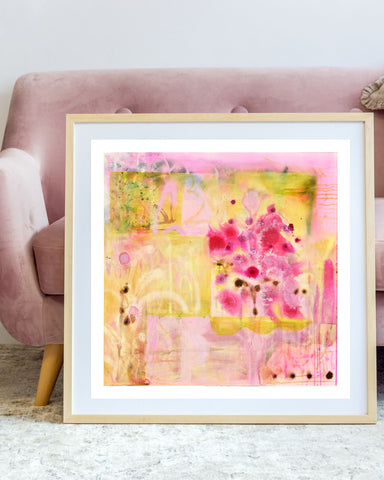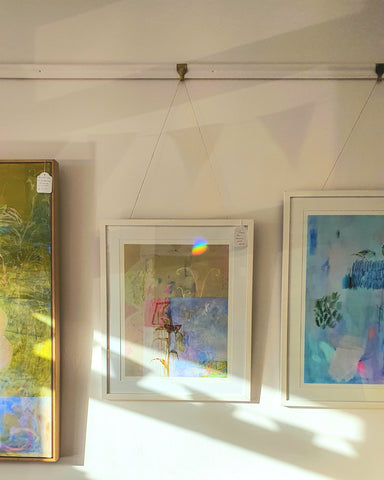How do I frame my fine art prints? A question I'm asked repeatedly. In this guide I'll tell you my favourite ways to frame prints and the questions you should consider when deciding on how to frame your art print.
Whether you are a seasoned collector or just have one or two pieces in your home, you will know that framing art, and framing it right, can add a stunning new dimension. Everything from the style, size, and colour of the frame to the way it’s mounted can change the look and feel of a piece entirely, thus altering the mood of the room in which it is hung. Here is a complete guide to framing it to ensure that you showcase your artwork perfectly!

These are some questions to consider before making the decision on how to frame your artwork:
1) What material do I want for my frame?
2) Which colour do I want the frame to be?
3) Do I want a mount around the print or do I want the edges of the paper to be visible?
4) Do I choose plain or non-reflective glass?
But before we delve into those, my first recommendation would be to bring your new artwork straight to your local framers once it arrives - without opening it at home to avoid damage, as tempting as it is! Going to a great local framer who will help you choose the right durable materials and custom frame is very important. This gicleé fine art print that you have chosen has been lovingly printed from my studio using archival inks and paper, quality that is made to last a lifetime. So it is no wonder that approaching the framing with the same care, attention and professionalism will not only elevate the look and feel of your precious art piece but it also helps with the longevity of your archival fine art print by protecting the artwork with quality framing materials.
Regardless of how you frame your art, always make sure you are using archival-quality materials; that means looking for acid-free tapes, backings, and mats, which will keep the delicate paper from aging too quickly. Art prints on paper, should always be framed behind glass and hung out of direct sunlight (which can break down the paper and bleach the pigments) and away from moisture (which can cause mildew or mold or even make the art stick to the frame or glass itself, causing irreparable damage).

1. What material do I want for my frame?
The most common materials are wood or metal. Metal frames can be thinner than wooden ones. I prefer wooden frames because of the texture. The perfect frame for me would be a wooden frame, as thin as possible without rounded corners. For example, the image below is a 30 x 40 cm print framed with a mount of 50 mm and a beautiful wood frame in white 22mm. If you love the look and texture of wood, go for that option. If you want a frame that is as thin as possible, then maybe choose metal.

All of my limited edition fine art prints come with a white border. This space allows me to title, number and hand sign the bottom of each print. It gives space around the edges so when framed, none of the image is covered by the front frame lip. It also gives the look of having a "built-in" mat around the print, which can work well if you are deciding to frame without a mount.
2. Which colour do you choose for the frame?
Frames come in a variety of colours. When choosing colour, always consider the wall where you're going to hang your print. Also consider if there are any other paintings close by that have frames in a certain colour or shape. Essentially, you want to create a harmonious flow between the artwork, the furniture and colours in a room. I recommend a white wood, natural wood or warm toned frame for most of my artwork. Choosing a frame that fits with your design aesthetic is a beautiful way of making artwork a natural part of the room. If you like something a little more vintage and ornate, go for a large gold gilded frame, I'm partial to a bit of gold glam myself!

3. Do I want a mount/mat around the print or do I want the edges of the paper to be visible?
A picture mount is an acid free cardboard cut out "window". It's slightly bigger than the image of the artwork. Often times, adding a mat can make your artwork look more elegant. The piece will take up more space on your wall which will highlight your beautiful art. Matting serves both aesthetic and practical purposes. It provides a buffer between the print and the glass, preventing any potential damage due to condensation. As mentioned before my fine art prints come with a narrow white border, this means the prints can be framed without a mount and without losing any of your image under the frame. Adding a mat is completely a personal preference, do what feels and looks right to you. If you are choosing a mount, be mindful that the colour goes well with the colour of the print paper. Your local framer will have mounts in a variety of colours, widths and depths, and will be able to guide you on choosing a mat color that complements the artwork and enhances its visual impact.
4. Do I choose Plain or Non-reflective Glass?
There are many different types of glass, they all do different jobs and require different budgets. The two most popular options would be plain glass or non-reflective glass. Choosing which glass to go for is entirely up to you. I'll give you some basic information about both below and you can consider which is best for your art piece.
Plain glass, is the most standard and is the cheaper option. It provides protection from the environment including UV, dust etc. It gives you the ability to see the print clearly and allows the colours and detail of the artwork to retain their clarity. However, you will be able to see some reflections in the glass, especially if it's hung in a sunny room or if there is a lot of light pollution in the room.
Conservation/ Non-reflective glass (NRG), sometimes known as non-glare, anti-glare or diffused glass can be a bit more expensive than plain glass. Conservation or museum-grade glass protects your fine art print from UV rays, dust, and moisture. This type of glass minimizes reflections and provides optimal clarity while preserving the colors and details of the print. It's wonderful to use in a sunny room or a room where there will be lots of light as you won't get any unwanted reflections in your beautiful art piece.
In my opinion, each artwork should be treated individually, taking into consideration the environment in which it will hang in and your overall budget.


With all this in mind, you may be wondering... will my print fit into a ready-made frame? Can I frame this myself?
I am totally aware of the expense of having your artwork professionally framed. Sometimes you may spend the same or even more money on framing than you did purchasing your fine art print. This price reflects the incredible quality, expertise and finish that is incomparable. Yet, if your budget is not stretching that far and you would still love to have some beautiful artwork on your walls, I have put together a DIY-framing guide below.
If you have ordered the 30 x 40 cm, 30 x 30cm, 40 x 50 cm or 50 x 70cm size prints – these fit in to ready-made frames that you can purchase at your local home ware store or online*
There are a few things to remember when you are DIY-framing…
1.Wait until you have an ample amount of time & all the bits to frame the artwork before you take it out of its original packaging.
2. Remove the artwork from its packaging carefully in a clean environment. When handling fine art prints, do so with clean hands to avoid transferring oils or dirt onto the surface
3. Avoid touching the face of the print AT ALL and just hold the outer edges lightly.
4. If you are framing with a mount/mat board, please use artist quality acid-free tape ONLY (do not use sellotape, masking tape or any other tapes please, we want to keep your beautiful new piece as archival, damage-free & long lasting as possible)
5. After you have the art securely taped to the mount, clean the glass/ plexiglass to remove any dust or fingerprints (v v important) When you have it clean, pop the mount and the backer into the frame and voila you are done! Extra little tip, tape the “Certificate of Authenticity” that you received with your print to the back of the frame for a professional finish.
*Please note, all other print sizes in my shop not listed above will require a professional framer.

